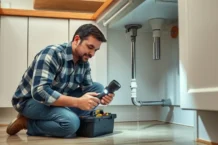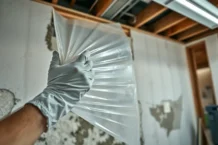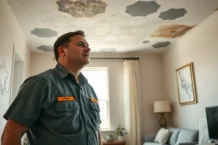—
Preparing Your San Diego Home for Rainy Season
As the rainy season comes to San Diego, preparing your home is wise. You want to avoid water damage and keep safe. You can protect your home from heavy rain and flooding by taking some easy steps.
San Diego Rainy Season Tips: Pre-Storm Checklist for Homeowners
To stay safe during storms, make a pre-storm checklist with essential tasks to do:
- Inspect Roof and Gutters: Look for missing shingles or debris in the gutters.
- Seal Windows and Doors: Make sure windows and doors are sealed tight to keep out moisture.
- Test Sump Pumps: If you have a sump pump, check if it works well.
- Clear Drainage Areas: Remove leaves or anything blocking drainage around your home.
Doing these steps helps with water damage prevention and prepares you for emergencies.
Create a Comprehensive Inspection Plan
A good inspection plan is key for property preservation before the rain starts. Start by checking plumbing for leaks that can cause moisture problems later. Check under sinks, behind toilets, and in any basements.
Look at places like attics and crawlspaces where dampness can hide. If needed, use dehumidifiers to control humidity levels.
Make a list of any issues during inspections so repairs can be done quickly before the storms arrive.
Evaluate and Maintain Landscaping Drainage
Landscaping helps manage rainwater around your home. Start by checking how well your landscaping drainage works, like French drains or swales that guide water away from foundations.
Trim plants near these areas so they don’t block water flow during heavy rain. Adding mulch or gravel around plant beds helps soak extra moisture while stopping soil erosion.
Talk to local experts who understand stormwater challenges for urban flooding solutions specific to San Diego’s environment.
Prepare Emergency Supplies and Communication Plans
Being ready for emergencies means having supplies, too! Stock up on basics like flashlights, batteries, non-perishable food, bottled water, first-aid kits, and pet supplies if needed!
Make plans with family about staying in touch during lousy weather—text messaging works best since phone lines can get busy when storms hit suddenly.
By getting these things done now instead of waiting until it’s stormy outside, you’ll be much better prepared when the rainy season starts!

Water Damage Prevention: Protecting Your San Diego Home
Water damage can be a big problem for homeowners in San Diego. During the rainy season, protecting your home from flooding and water problems is vital. Here are some tips to help with water damage prevention:
Flooding Prevention Tips
- Inspect Gutters and Downspouts: Keep gutters clean. Make sure downspouts send water away from your home’s foundation.
- Seal Windows and Doors: Look for gaps or cracks around windows and doors. Fill these with weather stripping or caulk.
- Landscape Wisely: Design your yard so that rainwater flows away from your home’s foundation. Use drainage swales or berms.
- Install Sump Pumps: If your area floods often, think about putting a sump pump in your basement or crawl space. This helps remove extra water fast.
- Use Moisture Control Products: Dehumidifiers inside during rainy times to decrease moisture levels.
Following these flooding prevention tips can keep your home safe and dry during storms.
Home Flood Protection: Minimizing Risks in San Diego
To protect your home from floods in San Diego, there are specific strategies you can use:
Flood Mitigation Strategies
- Elevate Utilities: Raise electrical panels, HVAC systems, and other utilities above possible flood levels.
- Install Flood Barriers: Use sandbags or flood barriers around areas of your property that could get wet.
- Assess Insurance Coverage: Check your homeowner’s insurance to ensure it covers floods. You might need extra flood insurance too.
These steps help reduce the chance of severe damage and support storm damage restoration if needed.
Identifying and Addressing Hidden Leaks
Hidden leaks can cause significant problems like mold if you don’t catch them early:
Plumbing Issues
Look at plumbing fixtures like sinks and toilets for leaks. Check under cabinets for signs like water stains or soft spots on walls.
Water Intrusion
After heavy rains, check basements and crawl spaces for standing water. This might mean there’s a leak that needs fixing.
If you find mold due to leaks or humidity, call mold removal services quickly before it gets worse.
By taking care of visible maintenance tasks and looking for hidden problems early, you can better protect your home from seasonal storms while safeguarding one of life’s most significant investments—your home!
Roof Leak Prevention: Maintaining Your Roof During San Diego’s Rainy Season
When it rains in San Diego, your roof needs special care. Keeping your roof in good shape is essential to stop leaks and avoid water damage. Here are some easy ways to help with roof leak prevention:
- Look at Your Roof Regularly: Check your roof a couple of times each year, especially before it starts to rain. Look for broken shingles or cracks.
- Clean Your Gutters and Downspouts: If gutters are clogged, water can go back onto your roof. Clean out leaves and dirt so the water can flow away.
- Seal Up Cracks and Gaps: Check around chimneys, vents, and skylights for any openings where water could get in. Use roofing cement to fix these spots.
- Think About Waterproofing: Waterproofing your home means adding a special coating on the roof that keeps out water. This can help protect against leaks during heavy rain.
- Trim Nearby Trees: Cut back branches that hang over your roof so they don’t break off and fall during storms or make a mess in your gutters.
By following these tips every year, you will be better prepared for emergencies and can prevent costly residential water damage restoration.
Drainage Solutions San Diego: Preventing Water Buildup
Having reasonable drainage solutions is essential for managing rainwater runoff in places like San Diego, where heavy rains can cause flooding:
- Install French Drains: These unique systems remove rainwater from your house’s foundation.
- Make Rain Gardens: Plant areas that catch rainwater so it can soak into the ground instead of pooling around homes.
- Use Permeable Pavers: Use materials that let rainwater seep through for driveways or patios instead of just running off.
- Put in Foundation Drainage Systems: These systems help keep groundwater from gathering near basements, which stops moisture problems later on.
- Explore Urban Flooding Solutions: Cities often have plans to manage stormwater like creating retention basins to reduce flood risks while helping the environment.
Rain Gutter and Downspout Maintenance
Keeping rain gutters and downspouts working well is key for controlling moisture when it rains:
- Clean out gutters regularly—at least twice a year—to remove leaves and dirt that can block water flow.
- Make sure downspouts are directing water away from your home’s foundation—about six feet is best—to keep erosion at bay.
- You might want to think about installing gutter guards; they keep larger debris out while still letting water flow freely.
Following these flooding prevention tips helps keep your home safe from too much moisture over time!
Waterproofing Your San Diego Home: Essential Steps
Waterproofing your home is super important, especially in San Diego. Heavy rains can cause water intrusion and damage. Here are some easy steps to help with moisture control and keep your house safe.
- Inspect the Roof
Check your roof for any damage. Look for missing shingles or cracks. Fix these right away to stop leaks during the rainy season. - Clean Gutters and Downspouts
Make sure your gutters are clean. Remove leaves and dirt. If they get clogged, water can overflow and pool near your foundation. Always point downspouts away from your house to help avoid flooding. - Seal Windows and Doors
Look at the seals around your windows and doors. If you see gaps, use weatherstripping or caulk to fill them in. This stops rainwater from coming inside. - Install Foundation Drainage Systems
It’s very important to have good drainage around your foundation. This helps move extra rainwater away from your house. You might want to think about installing French drains or a sump pump. - Apply Waterproof Coatings
You could put waterproof coatings on walls or foundations that get wet often for even more protection.
Following these steps can help reduce the risk of water damage when San Diego has its rainy days.
Emergency Water Cleanup Procedures: What to Do After a Flood
If your home floods due to heavy rain, acting quickly is key for emergency water cleanup:
- Ensure Safety First
Before you start cleaning up, check for any dangers like electrical wires in the water or damage that might be risky. - Turn Off Electricity
If it’s safe, switch off the electricity at the main breaker before going into flooded areas. This keeps you safe from electric shock while you clean up. - Remove Standing Water Quickly
Use pumps or wet/dry vacuums to remove water fast—this helps prevent more damage from staying wet too long. - Dry Out Affected Areas
Open windows and use fans or dehumidifiers after removing most of the water; this helps improve indoor air quality by ensuring everything dries out within 24-48 hours. - Check For Mold Growth Potential
Keep an eye on wet areas because mold can grow quickly in damp spots; be ready with mold removal services if needed.
Quick action speeds up recovery and helps keep indoor air quality reasonable after storm-related problems.
Mold Prevention San Diego: Protecting Your Home from Mold Growth
Mold can cause health problems and harm homes if not taken care of—here’s how you can stop it:
- Control Indoor Humidity Levels
Try to keep humidity below 60%. You can use dehumidifiers when it gets too humid; this makes it harder for mold to grow inside. - Fix Plumbing Issues Promptly
Take care of any plumbing leaks immediately; standing moisture can lead to mold growing behind walls without you noticing until it’s terrible. - Ventilate Areas Prone To Moisture
Make sure places like bathrooms, kitchens, laundry rooms, basements, and attics have good airflow; this cuts down on dampness that helps mold grow. - Regular Inspections And Cleaning
Check different parts of your home regularly and clean surfaces often to keep them dry; pay close attention to corners where mold likes to hide.
Doing these things will help protect against unwanted mold growth, keeping your living space healthy!
Storm Preparedness for Homeowners: A San Diego Guide
Getting ready for storms is super important, especially in San Diego. The weather can change quickly and lead to flooding and damage. Here are some steps homeowners should take to stay safe:
- Emergency Preparedness: Make an emergency plan. Talk with your family about what to do during a storm. Everyone should know how to contact each other.
- Flooding Prevention Tips:
- Clean your gutters and downspouts often. This helps water flow properly.
- Use sandbags in areas of your yard that might flood.
- Put sump pumps in basements or low spots to remove extra water.
- Winterization Tips:
- Check your roof for leaks and fix them before the rainy season.
- Seal windows and doors to keep drafts and water out.
- Wrap pipes to prevent them from freezing when it’s cold.
Following these tips can help keep your home safe from storms.
Homeowners Insurance and Flood Insurance: Understanding Your Coverage
Knowing your insurance coverage is key to protecting your home from storm damage.
Importance of Reviewing Your Policy
Check your home insurance and flood insurance regularly. You need to know what is covered during severe weather events. Many homeowners think their standard policies cover all water damage, but this isn’t always true—especially with floods from heavy rain.
Types of Coverage Available
Insurance options include:
- Home Insurance: Covers damage from wind or hail but may not include flood-related issues.
- Flood Insurance: Protects against water damage caused explicitly by flooding, which might not be part of regular homeowner’s policies.
Understanding flood mitigation strategies is essential to find the best protection for where you live.
Tips for Filing a Claim After Water Damage
If stormwater damages your home, here are steps to file a claim:
- Take pictures of all the damage before cleaning up.
- Call your insurance provider as soon as possible after checking the damage.
- Keep records of any emergency water cleanup you do before professionals arrive.
Being organized makes it easier to process claims and speeds up help from residential water damage restoration experts if needed.
Additional Considerations for San Diego Residents
Residents in San Diego deal with unique challenges like urban flooding due to its layout and weather patterns. To help control moisture:
- Make sure landscaping slopes away from the house,
- Regularly check drainage systems,
- Keep grading around homes well maintained.
These steps help protect properties against unexpected rainstorms while helping the whole community stay resilient against flooding during busy seasons.
Professional Water Damage Restoration Services in San Diego: Gold Coast Flood Restorations
Heavy rains can cause water damage in homes around San Diego. When this happens, it’s crucial to get help from professionals. Gold Coast Flood Restorations is here for you! We specialize in residential water damage restoration and storm damage restoration. Our team works hard to keep your home safe and dry after bad weather.
Emergency Water Cleanup
If there’s flooding, you need to act fast. Our emergency water cleanup service is ready to respond quickly. We want to help you minimize damage and stop issues like mold growth. With our special equipment, we can remove standing water from your property efficiently.
Flood Mitigation Strategies
Preventing future floods takes planning. We offer innovative flood mitigation strategies that fit your home’s needs. Some things we might do include:
- Installing sump pumps
- Improving drainage systems
- Waterproofing basements
These actions can help keep your home dry during heavy rains.
Mold Removal Services
Once we handle flooding, we must think about mold removal services too. If moisture stays behind, mold can grow quickly, which isn’t good for your health. Our experts check for mold and use effective methods to remove it safely.
Additional Tips for San Diego Homeowners: Protecting Your Property
Homeowners in San Diego should be ready for the rainy season to protect their properties.
Rainy Season Home Maintenance
Before the rains start, do some maintenance checks. Here are some tips:
- Clear gutters and downspouts of debris
- Inspect roofing materials for leaks
Doing these tasks helps ensure rainwater flows away from your foundation.
Heavy Rain Protective Measures
You might want to set up protective barriers around your yard. These barriers help manage rainwater runoff and protect your home. Think about adding landscaping features that include drainage solutions.
Urban Flooding Solutions
If you live near an area that often floods, look into urban flooding solutions. Options like permeable pavements let water soak into the ground instead of running off into the streets.
Preparing Your Yard for Heavy Rain
Your yard is key when it comes to handling heavy rain. Here are some ideas:
- Landscaping Drainage: Make sure rainwater drains away from buildings.
- Moisture Control: Create areas where plants need different amounts of water.
- Irrigation Systems: Set up timers on irrigation systems so you don’t over-water plants during unpredictable rainfall.
Identifying Vulnerable Areas in Your Home
To keep your home safe, watch out for vulnerable areas that might let water in:
- Water Intrusion: Check around windows and doors for gaps.
- Foundation Drainage: Keep drains clear around the foundation.
- Plumbing Issues: Regularly inspect pipes, especially under sinks, to catch leaks early.
Knowing these spots can better protect your home from water damage during storms!
FAQs About San Diego Rainy Season Water Damage Prevention
1. What are the common causes of water damage in San Diego during the rainy season?
Water damage in San Diego often comes from roof leaks, clogged gutters, and poor drainage. Heavy rain can overwhelm systems not set up for excess water.
2. How can I prevent mold growth in my home during heavy rains?
Control indoor humidity levels by using dehumidifiers. Fix leaks quickly to stop moisture buildup. Ensure good ventilation in areas prone to dampness.
3. What should I include in my emergency preparedness plan?
Make a plan that includes communication methods and a supply kit with food, water, and first-aid items. Ensure everyone knows the plan.
4. How does landscaping affect water drainage around my home?
Proper landscaping helps direct rainwater away from your foundation. Use swales or berms to control runoff and prevent flooding.
5. Why is foundation drainage important?
Foundation drainage prevents water from pooling near your home’s base. This reduces the risk of basement flooding and protects structural integrity.
Additional Tips for San Diego Homeowners
- Mold Prevention: Maintain humidity below 60%. Inspect plumbing regularly.
- Indoor Air Quality: Use air purifiers to keep air clean.
- Drought Mitigation: Implement xeriscaping techniques to reduce water use.
- Water Heater Maintenance: Flush your water heater annually to remove sediment.
- Pipe Insulation: Insulate pipes to protect against temperature changes.
- Weatherproofing: Seal gaps around windows and doors to keep moisture out.
- San Diego County Awareness: Be aware of local flood zones and emergency services.
- Community Preparedness: Connect with neighbors for shared resources during storms.
- Explore Areas: Research urban flooding solutions specific to La Jolla, Chula Vista, or El Cajon.
By following these strategies, you can safeguard your home from water damage this rainy season while enhancing safety for your family and property.









Follow Us!